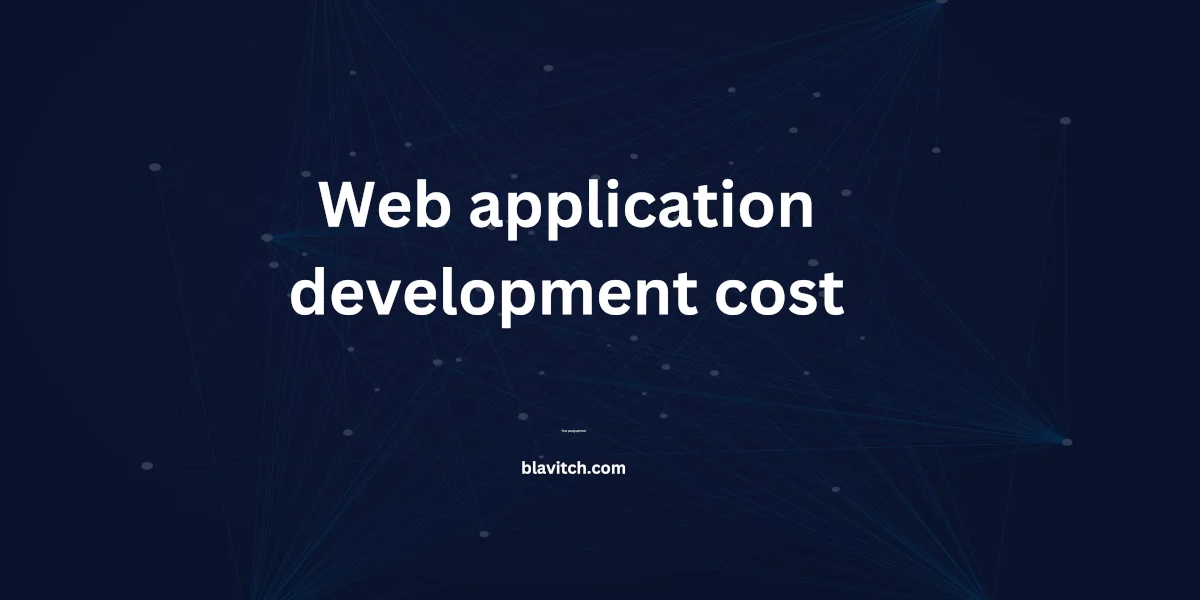- Home
- Product strategy
- Web application development co ...

The cost of developing a web app is not set in stone as it depends on various factors, including whether it falls under Web 2 or Web 3 development.
This broad term encompasses everything from creating an essential website to constructing a customized, feature-packed web application. However, making a well-informed investment and seeking the assistance of a professional web app development company can yield fruitful results.
The estimated cost for such a product can range from $1,500 to $250,000 or potentially more. To provide you with a general idea, here is a breakdown of the average cost to build web applications of varying complexity:
Simple Web Applications
- Cost Range: $1,500 to $7,000
- Description: Basic websites or small-scale apps with limited functionality and minimal interactivity. They typically involve static content and require straightforward development processes.
Medium-Sized Web Applications
- Cost Range: $9,000 to $30,000
- Description: More complex websites or apps with additional features, interactive elements, and content management systems (CMS). These applications may require integration with databases or APIs.
Custom Web Applications
- Cost Range: $30,000 to $250,000+
- Description: Tailor-made, feature-rich web applications with advanced functionality, intricate workflows, and extensive user interactions. These projects demand significant development efforts, including backend systems, robust databases, and detailed front-end design.
It is essential to remember that these figures are average estimates and can vary based on the specific requirements of your web app project. Factors such as design complexity, integration with external systems, security considerations, and scalability needs can all impact the overall cost.
What are the reasons for creating a web application?
Reasons for Creating a Web Application
Accessibility and Convenience
Web applications provide accessibility and convenience to users as they can be accessed from any device with an internet connection. Unlike traditional desktop applications, web apps eliminate the need for installation and updates, making them easily accessible anytime, anywhere.
Global Reach and Scalability
Web applications have the potential for global reach, allowing businesses to expand their customer base beyond geographical boundaries. With the internet being a global platform, web apps can easily scale and accommodate a growing number of users without significant infrastructure investments.
Cross-Platform Compatibility
Web applications are designed to be compatible across various platforms and devices, including desktops, laptops, tablets, and smartphones. They provide a consistent user experience across different operating systems, making them highly versatile and user-friendly.
Cost-Effectiveness
Compared to traditional software development, web application development is often more cost-effective. Web apps eliminate the need for separate development and maintenance for different platforms, reducing overall expenses. Additionally, cloud-based hosting options can further lower infrastructure costs.
Real-Time Collaboration and Updates
Web applications facilitate real-time collaboration among users, enabling seamless communication, document sharing, and simultaneous editing. This feature is particularly beneficial for businesses and teams working remotely or across different locations.
Easy Updates and Maintenance
Web applications simplify the process of updates and maintenance. Unlike traditional software, updates can be deployed centrally on the server, ensuring all users have access to the latest version instantly. This streamlines bug fixes, feature enhancements, and security patches, providing a seamless user experience.
Integration Capabilities
Web applications can integrate with various third-party services, APIs, and systems, enhancing their functionality and providing a seamless user experience. Integration with popular tools and platforms such as payment gateways, social media platforms, or cloud storage services can significantly improve business operations.
Data Centralization and Security
Web applications offer the advantage of centralizing data storage, ensuring information is securely stored in a dedicated server or the cloud. This minimizes the risk of data loss and provides better security measures, such as encryption and user authentication, to protect sensitive information.
Analytics and Insights
Web applications provide extensive analytics and reporting capabilities, allowing businesses to gather valuable insights about user behavior, engagement, and conversion rates. These insights enable data-driven decision-making, helping businesses optimize their strategies and improve overall performance.
Competitive Advantage
Having a web application can provide a competitive edge in today’s digital landscape. It showcases a commitment to technological advancement, enhances customer satisfaction, and enables businesses to stay ahead of the competition by delivering innovative solutions and exceptional user experiences.
In essence, the reasons for creating a web application include accessibility, global reach, scalability, cross-platform compatibility, cost-effectiveness, real-time collaboration, easy updates and maintenance, integration capabilities, data centralization, security, analytics, and insights, and gaining a competitive advantage.
Web applications offer businesses and users numerous benefits, making them a vital component in the digital age.
What factors affect the price of web application development?
Several factors influence the cost of web application development. Understanding these factors is crucial for estimating the price and planning your budget accordingly. Here are the key elements that can affect the overall cost:
Design Complexity
The complexity of the web application’s design significantly impacts the development cost. A simple, minimalist design with basic elements will be less expensive compared to a complex, visually-rich design with custom animations and intricate user interactions.
App Category and Functionality
The category and functionality of the web application also play a vital role in determining the cost. For instance, a basic informational website will generally cost less than an e-commerce platform or a data-intensive web application that involves complex backend processes.
Scope of Work
The scope of work required for web application development directly affects the cost. A larger scope, including more features, advanced functionalities, integration with external systems or APIs, and extensive user interactions, will generally result in higher development costs.
Development Team Location
The location of the development team impacts the pricing. Rates may vary based on the geographical location of the development team. Offshore or remote teams often offer cost advantages compared to onshore or local development teams, but it’s essential to consider the potential impact on communication and collaboration.
Project Timeline and Urgency
The project timeline and urgency of delivery can affect the development cost. Tight deadlines and accelerated development schedules may require additional resources or overtime work, which can increase the overall project cost.
Additional Expenses and Contingencies
Several additional expenses and contingencies may contribute to the overall cost. These can include licensing fees for specific technologies or frameworks, purchase of premium themes or plugins, third-party API integration costs, security measures such as SSL certificates, and unforeseen scope changes or bug fixes.
Scalability and Performance Requirements
If the web application needs to handle high user traffic or requires robust scalability and performance, additional resources and infrastructure may be necessary. This can impact the development cost, as more powerful servers, load-balancing mechanisms, or caching systems may be required.
Maintenance and Support
Consider the long-term maintenance and support requirements for the web application. Regular updates, bug fixes, security patches, and ongoing support may incur additional costs beyond the initial development phase.
Customization and Integration
Customization and integration with external systems, databases, or APIs can add to the development cost. The complexity and effort involved in integrating various components or creating custom functionality tailored to specific business needs contribute to the overall pricing.
User Experience and Accessibility
Delivering an exceptional user experience and ensuring accessibility may involve additional development efforts. Adhering to accessibility standards, optimizing the web application for various devices and screen sizes, and implementing user-friendly interfaces may impact the development cost.
Web application development cost: Price estimation example
Sample Price Estimation for Web Application Development
To provide you with a rough estimation of the costs involved in developing different types of web applications, here are some sample price ranges for various projects:
Web-Based Marketplace like Jumia
Developing a web-based marketplace similar to Jumia, an e-commerce platform, involves complex functionality and integration. The estimated cost for such a project can range from $20,000 to $150,000, depending on the scope, customization, payment gateways, product management, user reviews, and seller management features.
CRM Systems like ClickUp
Creating a Customer Relationship Management (CRM) system like ClickUp requires advanced functionalities, data management, user roles, task tracking, and collaboration features. The estimated cost for developing a CRM system can range from $10,000 to $100,000, considering the complexity and customization requirements.
Online Learning Management System(LMS)
Developing an online learning management system (LMS) involves features such as course management, user registration, content delivery, assessments, and student tracking. The estimated cost for an LMS can range from $30,000 to $80,000, depending on the complexity, customization, and integration with e-learning tools or payment gateways.
Travel Booking Application
Creating a travel booking application with features like flight and hotel search, booking, payment integration, itinerary management, and reviews requires integration with multiple APIs and complex backend processes. The estimated cost for a travel booking application can range from $20,000 to $150,000, depending on the scale, customization, and third-party integrations.
Crypto-Based Fintech Application
Developing a fintech application with cryptocurrency-related functionality, such as wallet management, crypto trading, and portfolio tracking, requires robust security measures and integration with external cryptocurrency exchanges. The estimated cost for a crypto-based fintech application can range from $50,000 to $200,000, depending on the complexity, security requirements, and integration with blockchain networks.
Virtual Card Web Application
Creating a virtual card web application involves features like card issuance, transactions, balance management, and integration with payment gateways or financial institutions. The estimated cost for a virtual card web application can range from $5,000 to $10,000, depending on the customization, security measures, and compliance requirements.
Sales of Gift Cards
Developing a web application for selling gift cards involves functionalities such as gift card selection, customization, purchasing, payment integration, and delivery options. The estimated cost for a gift card sales web application can range from $3,000 to $6,000, depending on the complexity of the design, customization requirements, integration with e-commerce platforms, and additional features like gift card balance tracking and redemption.
Web application cost estimation at Blavitch
At Blavitch, we follow a comprehensive approach to cost web application projects, taking into account various factors that influence the development process. Our goal is to provide our clients with accurate and transparent pricing estimates. Here’s an overview of how we cost web application projects:
Requirements Gathering
We begin by conducting in-depth discussions with our clients to understand their specific needs, goals, and desired features for the web application. This helps us establish a clear scope of work and gather all the necessary requirements.
Project Analysis and Planning
Our team of experts analyzes the gathered requirements and develops a detailed project plan. We assess the complexity of the design, functionality, and integration requirements to determine the resources and effort needed.
Design and User Experience (UX)
We consider the design complexity and the level of user experience desired for the web application. This includes factors such as branding, visual elements, interactivity, and overall user interface design. The complexity of the design influences the development cost.
Development Effort
Based on the project plan and requirements, we estimate the development effort required to build the web application. This includes frontend development, backend development, database design, third-party integrations, and any additional custom features or functionalities.
Team Composition and Expertise
We consider the composition of our development team, including the required roles and expertise. The number of developers, designers, project managers, and quality assurance specialists involved in the project can impact the overall cost.
Technology Stack
The choice of technology stack also influences the cost. We evaluate the project requirements and select the most suitable technologies, frameworks, and tools. Complex or specialized technologies may require additional resources or expertise, affecting the overall pricing.
Testing and Quality Assurance
We allocate resources for thorough testing and quality assurance to ensure the web application meets the highest standards. The complexity of the project, the need for automated testing, and the extent of quality assurance efforts contribute to the overall cost.
Project Timeline
We consider the project timeline and any specific deadlines or time constraints. If an expedited development schedule is required, additional resources or overtime work may be necessary, impacting the project cost.
Additional Factors
We account for other factors such as scalability requirements, security considerations, ongoing maintenance, and support needs. These elements are evaluated to provide a comprehensive cost estimation.
Transparent Pricing
Once we have gathered all the necessary information, we provide our clients with a detailed breakdown of the cost, ensuring transparency and clear communication. Our pricing includes all the essential components involved in the web application development process.
At Blavitch, our pricing strategy aims to strike a balance between delivering high-quality web applications and providing competitive pricing. We believe in providing value to our clients by offering cost-effective solutions that meet their unique requirements and business objectives.
It’s worth noting that each project is unique, and the cost estimation process may vary based on individual circumstances. We encourage clients to reach out to us for a detailed discussion about their specific web application project so that we can provide an accurate and tailored pricing estimate.
Conclusion
In conclusion, the cost of web application development is determined by multiple factors. Design complexity, app category, scope of work, team location, and other elements actively influence the overall price. It is vital for businesses to consider these factors and collaborate with experienced professionals to obtain accurate cost estimations.
By understanding the key drivers of web application development cost, businesses can make informed decisions and effectively allocate resources, ensuring the successful realization of their web application projects.
Ready to develop your web application? Partner with Blavitch for expert guidance and transparent pricing. Contact us now to discuss your project and get started on bringing your vision to life. Together, let’s create a powerful and successful web application that exceeds your expectations.







